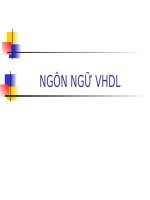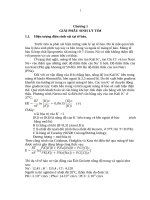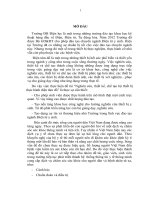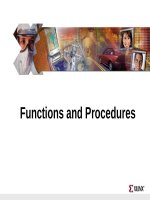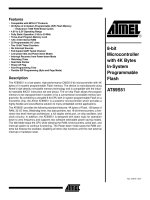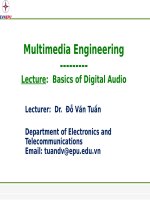ĐIỆN tử VIỄN THÔNG audio engineering khotailieu
Bạn đang xem bản rút gọn của tài liệu. Xem và tải ngay bản đầy đủ của tài liệu tại đây (629.62 KB, 32 trang )
Multimedia Engineering
--------Lecture: Basics of Digital Audio
Lecturer: Dr. Đỗ Văn Tuấn
Department of Electronics and
Telecommunications
Email:
Lecture contents
1. Digitalization of Sound
2. Quantization and Transmission Audio
2
What is Sound?
Sound is a wave phenomenon like light, and involves molecules of air being
compressed and expanded under the action of some physical device.
For example, a speaker in an audio system vibrates back and forth and
produces a longitudinal pressure wave that we perceive as sound. Since sound
is a pressure wave, it takes on continuous values, as opposed to digitized ones.
Even though such pressure waves are longitudinal, they still have ordinary
wave properties and behaviors, such as reflection (bouncing), refraction
(change of angle when entering a medium with a different density) and
diffraction (bending around an obstacle).
If we wish to use a digital version of sound waves we must form digitized
representations of audio information.
3
Digitization
Digitization means conversion to a stream of numbers, and preferably these
numbers should be integers for efficiency.
Figure below shows the 1-dimensional nature of sound: amplitude values
depend on a 1D variable, time. (And note that images depend instead on a 2D
set of variables, x and y).
Figure: An analog signal: continuous measurement of pressure wave
4
Sampling and Quantization
The graph in the above figure has to be made digital in both time and
amplitude. To digitize, the signal must be sampled in each dimension: in time,
and in amplitude.
Sampling means measuring the quantity we are interested in, usually at evenlyspaced intervals.
The first kind of sampling, using measurements only at evenly spaced time
intervals, is simply called, sampling. The rate at which it is performed is called the
sampling frequency.
For audio, typical sampling rates are from 8 kHz (8,000 samples per second) to 48
kHz. This range is determined by Nyquist theorem (discussed later).
Sampling in the amplitude or voltage dimension is called quantization.
Thus to decide how to digitize audio data we need to answer the following
questions:
What is the sampling rate?
How finely is the data to be quantized, and is quantization uniform?
How is audio data formatted? (file format) Signals can be decomposed into a sum
of sinusoids.
5
Nyquist Theorem
Signals can be decomposed into a sum of sinusoids.
Figure: Building up a complex signal by superposing sinusoids
6
Nyquist Theorem
Frequency is an absolute measure, pitch is generally relative – a perceptual
subjective quality of sound.
Pitch and frequency are linked by setting the note A4 exactly 440 Hz.
An octave above that note takes us to another A note. An octave
corresponds to doubling the frequency. Thus with the middle “A” on a
piano (“A4” or “A440”) set to 440 Hz, the next “A” up is at 880 Hz, or
one octave above.
Harmonics: any series of musical tones whose frequencies are integral
multiples of the frequency of a fundamental tone.
If we allow non-integer multiples of the base frequency, we allow non-“A”
notes and have a more complex resulting sound.
7
Nyquist Theorem
The Nyquist theorem states how frequently we must sample in time to be able
to recover the original sound. For correct sampling we must use a sampling rate
equal to at least twice the maximum frequency content in the signal. This rate
is called the Nyquist rate.
Nyquist Theorem: If a signal is band-limited, i.e., there is a lower limit f1 and
an upper limit f2 of frequency components in the signal, then the sampling rate
should be at least 2(f2 − f1).
Nyquist frequency: half of the Nyquist rate. Since it would be impossible to
recover frequencies higher than Nyquist frequency in any event, most systems
have an anti-aliasing filter that restricts the frequency content in the input to the
sampler to a range at or below Nyquist frequency.
8
Signal to Noise Ratio
The ratio of the power of the correct signal and the noise is called the signal to
noise ratio (SNR) – a measure of the quality of the signal.
The SNR is usually measured in decibels (dB), where 1 dB is a tenth of a bel.
The SNR value, in units of dB, is defined in terms of base-10 logarithms of
squared voltages, as follows:
SNR 10 log10
2
VSignal
V
2
Noise
20 log10
VSignal
VNoise
The power in a signal is proportional to the square of the voltage.
For example, if the signal voltage VSignal is 10 times the noise, then the SNR is
20 log10(10) = 20dB.
In terms of power, if the power from ten violins is ten times that from one
violin playing, then the ratio of power is 10dB, or 1B.
9
Signal to Quantization Noise Ratio
Aside from any noise that may have been present in the original analog signal,
there is also an additional error that results from quantization.
If voltages are actually in 0 to 1 but we have only 8 bits in which to store
values, then effectively we force all continuous values of voltage into only
256 different values.
This introduces a round-off error. It is not really “noise”. Nevertheless it is
called quantization noise (or quantization error).
The quality of the quantization is characterized by the Signal to Quantization
Noise Ratio (SQNR).
Quantization noise: the difference between the actual value of the analog
signal, for the particular sampling time, and the nearest quantization interval
value.
At most, this error can be as much as half of the interval.
For a quantization accuracy of N bits per sample, the SQNR can be simply
N1
V
2
expressed:
Signal
Signal
SNR 20 log10
VQuan _ noise
20 log10
1/ 2
20 N log 2 6.02 NdB
10
Signal to Quantization Noise Ratio
Notes:
We map the maximum signal to 2N-1 − 1 and the most negative signal to −2N-1.
Equation above is the Peak signal-to-noise ratio, PSQNR: peak signal and peak
noise.
The dynamic range is the ratio of maximum to minimum absolute values of the
signal: Vmax/Vmin. The max abs. value Vmax gets mapped to 2N-1 − 1; the min abs.
value Vmin gets mapped to 1. Vmin is the smallest positive voltage that is not
masked by noise. The most negative signal, −Vmax, is mapped to −2N-1.
The quantization interval is ∆V = (2Vmax)/2N, since there are 2N intervals. The
whole range Vmax down to (Vmax − ∆V/2) is mapped to 2N-1 − 1.
The maximum noise, in terms of actual voltages, is half the quantization
interval: ∆V/2 = Vmax/2N .
11
Signal to Quantization Noise Ratio
6.02N is the worst case.
If the input signal is sinusoidal, the quantization error is statistically
independent, and its magnitude is uniformly distributed between 0 and half of
the interval, then it can be shown that the expression for the SQNR becomes:
SQNR = 6.02N + 1.76(dB)
12
Audio Filtering
Prior to sampling and AD conversion, the audio signal is also usually filtered to
remove unwanted frequencies. The frequencies kept depend on the application:
For speech, typically from 50Hz to 10kHz is retained, and other
frequencies are blocked by the use of a band-pass filter that screens out
lower and higher frequencies.
An audio music signal will typically contain from about 20Hz up to
20kHz.
At the DA converter end, high frequencies may reappear in the output –
because of sampling and then quantization, smooth input signal is replaced
by a series of step functions containing all possible frequencies.
So at the decoder side, a low-pass filter is used after the DA circuit.
13
Audio Quality vs Data Rate
The uncompressed data rate increases as more bits are used for quantization.
Stereo: double the bandwidth to transmit a digital audio signal.
Table: Data rate and bandwidth in sample audio applications
14
Synthetic Sound
FM (Frequency Modulation): one approach to generating synthetic sound:
Wave Table synthesis: A more accurate way of generating sounds from digital
signals. Also known, simply, as sampling.
In this technique, the actual digital samples of sounds from real instruments are
stored. Since wave tables are stored in memory on the sound card, they can be
manipulated by software so that sounds can be combined, edited, and
enhanced.
15
Synthetic Sound
Figure: Frequency Modulation. (a): A single frequency. (b): Twice the frequency. (c):
Usually, FM is carried out using a sinusoid argument to a sinusoid. (d): A more complex
form arises from a carrier frequency, 2πt and a modulating frequency 4πt cosine inside
the sinusoid
16
Lecture contents
1. Digitalization of Sound
2. Quantization and Transmission Audio
17
Quantization and Transmission Audio
Coding of Audio: Quantization and transformation of data are collectively
known as coding of the data.
For audio, the μ-law technique for companding (Compressing and
Expanding) audio signals is usually combined with an algorithm that
exploits the temporal redundancy present in audio signals.
Differences in signals between the present and a past time can reduce the
size of signal values and also concentrate the histogram of pixel values
(differences, now) into a much smaller range.
The result of reducing the variance of values is that lossless compression
methods produce a bit-stream with shorter bit lengths for more likely
values.
In general, producing quantized sampled output for audio is called PCM (Pulse
Code Modulation). The differences version is called DPCM (and a crude but
efficient variant is called DM). The adaptive version is called ADPCM.
18
Pulse Code Modulation
The basic techniques for creating digital signals from analog signals are
sampling and quantization.
Quantization consists of selecting breakpoints in magnitude, and then
remapping any value within an interval to one of the representative output
levels.
The set of interval boundaries are called decision boundaries, and the
representative values are called reconstruction levels.
The boundaries for quantizer input intervals that will all be mapped into
the same output level form a coder mapping.
The representative values that are the output values from a quantizer are a
decoder mapping. Finally, we may wish to compress the data, by assigning
a bit
19
Pulse Code Modulation
Every compression scheme has three stages:
The input data is transformed to a new representation that is easier or
more efficient to compress.
We may introduce loss of information. Quantization is the main lossy step
we use a limited number of reconstruction levels, fewer than in the
original signal.
Coding: assign a codeword (thus forming a binary bit-stream) to each
output level or symbol. This could be a fixed-length code, or a variable
length code such as Huffman coding.
For audio signals, we first consider PCM for digitization. This leads to
Lossless Predictive Coding as well as the DPCM scheme; both methods use
differential coding. As well, we look at the adaptive version, ADPCM, which
can provide better compression.
20
PCM in Speech Compression
Assuming a bandwidth for speech from about 50 Hz to about 10 kHz, the
Nyquist rate would dictate a sampling rate of 20 kHz.
Using uniform quantization without companding, the minimum sample
size we could get away with would likely be about 12 bits.
Hence for mono speech transmission the bit-rate would be 240 kbps. (20K
× 12 bits)
With companding, we can reduce the sample size down to about 8 bits
with the same perceived level of quality, and thus reduce the bit-rate to
160 kbps.
However, the standard approach to telephony in fact assumes that the
highest-frequency audio signal we want to reproduce is only about 4 kHz.
Therefore the sampling rate is only 8 kHz, and the companded bit-rate
thus reduces this to 64 kbps.
21
PCM in Speech Compression
However, there are two small wrinkles we must also address:
Since only sounds up to 4 kHz are to be considered, all other frequency
content must be noise. Therefore, we should remove this high-frequency
content from the analog input signal. This is done using a band-limiting
filter that blocks out high, as well as very low, frequencies.
A discontinuous signal contains not just frequency components due to the
original signal, but also a theoretically infinite set of higher-frequency
components:
This result is from the theory of Fourier analysis, in signal processing.
These higher frequencies are extraneous.
Therefore the output of the digital-to-analog converter goes to a lowpass filter that allows only frequencies up to the original maximum to
be retained.
22
PCM in Speech Compression
The complete scheme for encoding and decoding telephony signals is shown as
a schematic in the figure below. As a result of the low-pass filtering, the output
becomes smoothed.
Figure: PCM signal encoding and decoding
23
Differential Coding in Audio
Audio is often stored not in simple PCM but instead in a form that exploits
differences – which are generally smaller numbers, so offer the possibility of
using fewer bits to store.
If a time-dependent signal has some consistency over time (“temporal
redundancy”), the difference signal, subtracting the current sample from the
previous one, will have a more peaked histogram, with a maximum around
zero.
For example, as an extreme case the histogram for a linear ramp signal that has
constant slope is flat, whereas the histogram for the derivative of the signal
(i.e., the differences, from sampling point to sampling point) consists of a spike
at the slope value.
So if we then go on to assign bit-string codewords to differences, we can
assign short codes to prevalent values and long codewords to rarely occurring
ones.
24
Lossless Predictive Coding
Predictive coding: simply means transmitting differences – predict the next
sample as being equal to the current sample; send not the sample itself but the
difference between previous and next.
Predictive coding consists of finding differences, and transmitting these using
a PCM system.
Note that differences of integers will be integers. Denote the integer input
signal as the set of values f n . Then we predict values f n as simply the
previous value, and define the error en as the difference between the actual and
the predicted signal:
f
n
f n 1
en f n f n
But it is often the case that some function of a few of the previous values
f n1 , f n 2 , f n 3 ,... provides a better prediction. Typically, a linear predictor
function is used:
2 to 4
f n an k f n k
k 1
25

